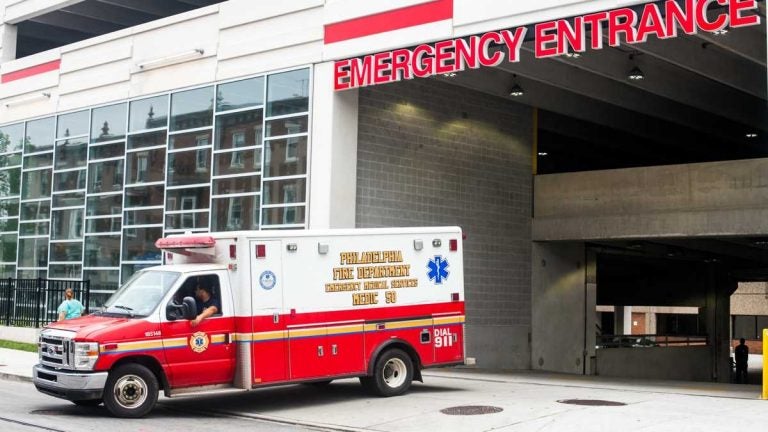Hospitals could play bigger role in preventing gun violence, study says
Research suggests intervention programs in hospitals could help gunshot victims steer clear of future violence.

In this file photo, an ambulance pulls out of the emergency entrance at Temple University Hospital. (Brad Larrison for WHYY)
A new study suggests hospital emergency rooms across the country could play a bigger role in preventing gun violence.
“The emergency department may be [gunshot victims’] only contact with the health care system, and what we know is that represents an opportunity to try and prevent a repeat injury,” said Dr. Kit Delgado, assistant professor of emergency medicine and epidemiology at the University of Pennsylvania and one of the researchers on the study.
One way trauma centers are working to prevent gun violence is through hospital-based intervention programs that can provide counseling and even educate people on gun safety.
Other research has shown these programs have found some success.
Yet out of more than 250 trauma centers in the country, Delgado said, only 25 have formal violence intervention programs. Philadelphia has two on the list.
One is Drexel University’s Healing Hurt People program, part of its Department of Emergency Medicine, and the Children’s Hospital of Philadelphia has the Violence Prevention Initiative.
The Violence Prevention Initiative enrolls 8- to 18-year-olds who enter its emergency room with violent injuries. Dr. Joel Fein, the co-director, said hospitals have more than an ethical imperative to invest resources in this cause.
“Just from an administrative point of view, billions of dollars a year are spent on violent injuries – not just in the immediate care, but in the post-emergency visit medical care, as well as the psychological care that’s necessary,” he said.
Other initiatives include Temple University Hospital’s Cradle to Grave prevention program that allows young people to get a behind-the-scenes look at treating a firearm wound.
Temple also operates Turning Point, where patients are offered counseling and job training.
“For us, as trauma surgeons, this is unfortunately what we’re seeing in our emergency rooms and our hospitals … our patients being shot. So it’s only natural for us as trauma surgeons and our hospital to want to address gun violence as a public health crisis,” said Dr. Amy Goldberg, chair of the department of surgery at Temple University Hospital.
She said the violence intervention is akin to a cardiologist recommending that a patient adopt a healthier diet or a pulmonologist advising a patient to quit smoking.
“We don’t practice medicine in a vacuum, right?” she said. “So we’re all here to make sure that we’re all put out of business.”
One way Philadelphia trauma centers could improve, Delgado said, would be enrolling more people into these intervention services even if they’re not being admitted to the hospital. Another is by developing best practices for educating people on gun storage safety.
The study published last week looked at national emergency room data from 2009 to 2014 as it related to gunshot wounds. It broke down where gunshot victims go for treatment and for what reason, and whether their gunshot wound was due to assault or an accidental discharge.
According to data collected, more than 36,000 gunshot victims survive – and 10 percent of them will return to an ER with a violent injury within one to two years.
WHYY is your source for fact-based, in-depth journalism and information. As a nonprofit organization, we rely on financial support from readers like you. Please give today.





